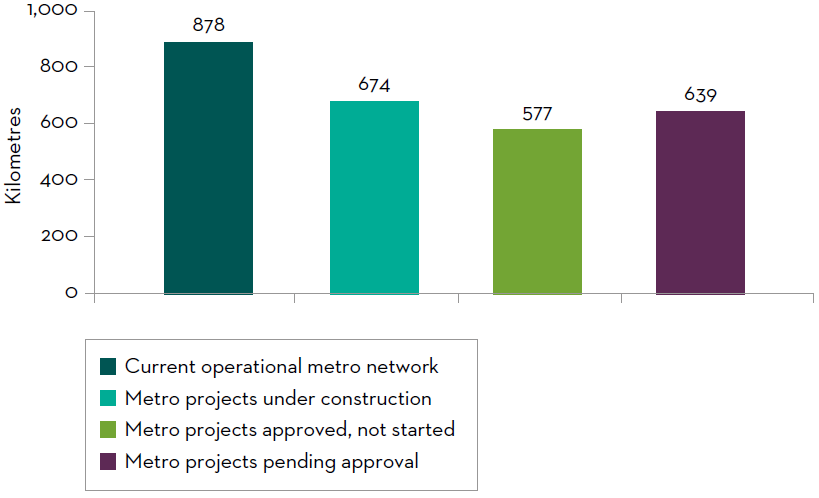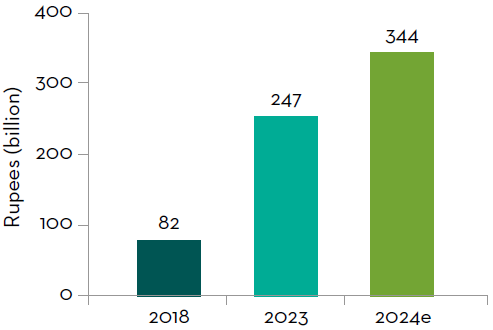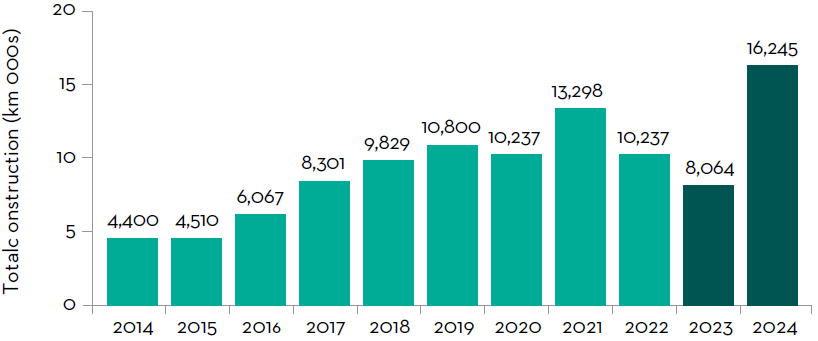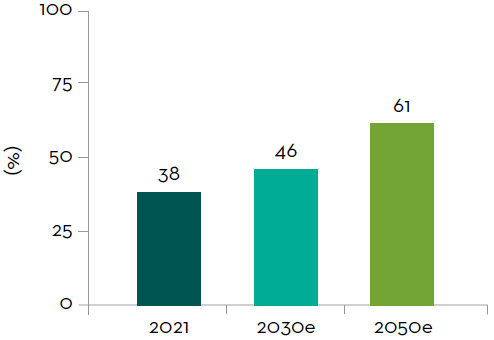Content navigation
India has the potential to drive emerging market (EM) returns over the next decade
- The world’s fastest growing major economy, India remains a multi-decade structural opportunity1
- It offers high returns, consistent earnings growth and strong governance2
- India is now the second largest country in the MSCI Emerging Markets, its highest weighting in the index3
India’s role in EM has significantly increased in recent years
India’s programme of structural reform is now enabling it to reach its potential. It has more than doubled its weight in the EM Index in just six years – from 8% to 20%4. Strong economic growth delivered in a period where global growth has been challenging has enabled the country to attract investors and power its market cap ascendancy. With tremendous growth in Gross Domestic Product (GDP) per capita as well – India has been able to deliver in-tandem stock market returns. market returns.
Weight of India in the MSCI Emerging Markets Index

Source: MSCI and FactSet, as of 30 June 2024.
Indian market capitalisation versus GDP per capita, 1997-2024

Source: Bloomberg, IMF, CEIC, Kotak Institutional Equities, June 2024. Data as of March fiscal year ends.
-
India’s programme of structural reform is now enabling it to reach its potential
Indian companies have delivered
Between 31 December 2019 and 31 December 2023, India outperformed EM by 72% and the US by 22%. It achieved this by delivering strong earnings growth.
Total return of India, EM and the US over four years

FactSet. Data shown is between 31 December 2019 to 31 December 2023.
India’s earnings growth in the past five years has surpassed that of the US by 76%, as shown by the chart below. This has supported its index outperformance. Consensus estimates point towards a continuation of this trend in higher earnings growth – with the three year compound annual growth rate (CAGR) for India approximately 30% higher for India than the US5. We believe India’s strong earnings growth and will drive the outperformance of EM.
Earnings-per-share growth for India versus the US

Source: FactSet, as at 27 June 2024. Past five years measured from 31 December 2018 to 31 December 2023, using reported earnings. Next three years measured using consensus estimates for the period 31 December 2023 to 31 December 2026. There can be no assurance that estimates will be realised.
Indian reforms provide structural support
What are some of the reforms being implemented in India?
Demonetisation and GST
The Indian government has decreased the notes in issue in India which effectively forced people to declare their cash (by banking it), driving a formalisation of the economy. On top of this, they introduced GST – a Goods and Services Tax – whose implications were that companies providing goods and services were incentivised to be more transparent in declaring their chain (of sales and purchases) to minimise the amount of tax they are required to pay. For example, a retailer would be liable to pay GST on the incremental difference between the item’s sold price and the price they paid their supplier. Without declaring both sides, they’d be liable for the whole amount.
These two reforms have driven a broader move towards the formal sector, where historically much of India’s market has been informal. Risks inherent in the informal market are the existence of local sellers with less professional business practices – less tax paying, customer due diligence. The reforms are broad-based but one area which has particularly benefitted is the jewellery market, which has historically been roughly two-thirds in the informal market. Further reforms in this market specifically, include the requirement of identification for purchases over a certain threshold (i.e. increased customer due diligence), and the introduction of hallmarking*. By channelling consumers towards the formal market, these reforms provide companies already operating in this segment with a huge structural opportunity. The bigger the historic tendency to the informal market, the bigger the potential opportunity.
Digitisation
One crucial area of structural change in India is digitisation. One of the most impactful changes in the past 15 years is the introduction of Aadhaar, a biometric identification system. This was launched in 2009 and has over 1.38 billion registered card holders – roughly 97% of the population6. Although it is not mandatory, it has several benefits, such as its use as proof of residence. We think the key area of opportunity born out of this is for India’s banking sector. A core requirement for opening a bank account is proof of residence – Aadhaar increases financial inclusion by giving people the means to open an account, essential for many jobs, businesses, or state benefits. Since introducing Aadhaar, the percentage of the population with bank accounts has increased from 35% in 2011 to 78% in 20217.
Related to this is the increase in digital payments. As the world becomes increasingly digitised, companies and people need to be able to transact digitally too. Obviously, one needs a bank account to do this. The government regularly publishes data on the number of digital payments in India and there is a clear upward trend, as shown below. In March 2024, the volume of digital payments made in India has more than doubled to almost 1 billion, compared to ~400 million five years earlier. With the Indian market becoming increasingly formalised and companies operating in India with a global footprint, we think this trend creates significant opportunity for investors, especially for the financial and fintech industry.
Digital payment adoption in India, 2017-2024

Source: RFI, Kotak Institutional Equities, June 2024. Data as of March fiscal year ends. Data shows Real-time Gross Settlement + National Electronics Fund Transfer + Immediate Payment Services.
Infrastructure investment
India has implemented a huge infrastructure development project, building roads, affordable housing, airports, and metro systems. These projects have made travel within India significantly more accessible and have also helped to broadly increase standards of living. This higher accessibility and improved living standards have several implications: increased jobs, more efficient commutes, increased leisure travel (internal and international tourism), and more.
The opportunity for investors is both specific and broad-based. Any increased investment in these areas has the potential to significantly boost productivity in India – the level of which is typically quite low, so any incremental increase can have a large impact on the economy as a whole. Furthermore, infrastructure and related sectors stand to benefit from government investment and projects in motion. This includes, for example, cement, which not only is used in many large infrastructure projects but also, surprisingly, has a meaningful retail market in India.
Indian metro rail length

Source: PIB, Kotak International Equities, June 2024.
Investment spend on railways

Source: Indian Railways, Kotak Institutional Equities, June 2024. Data as of March fiscal year end.
Road construction

Source: NHAI, Kotak Institutional Equities, June 2024. Data for 2023 and 2024 based on estimates. Data as of March fiscal year end.
Significant increases to urbanisation (% of households living in urban areas)

Source: NSSO – 66th round, CEIC, UN, Kotak Institutional Equities estimates June 2024. Data as of March fiscal year end.
Affordable housing loans growing (outstanding credit)
Source: Crisil, Kotak Institutional Equities estimates, June 2024. Data as of March fiscal year end.
We believe India's time has come
But what does all this mean for equity markets? India is early in its journey of significant reforms which have created a structural growth opportunity for investors. The country has already demonstrated the positive impact of this through its increased relevance in the EM asset class. Although the structural reforms have been supportive, it is the companies themselves which have delivered on earnings and are expected to continue delivering in the years to come. We believe that India has the potential to drive returns in EM over the next decade as the structural growth opportunities come to fruition and companies rise to the challenges presented to them.
Sources
1Source: Factset as at 2 August 2024..
2BBC News as at 1 March 2024.
3Source: MSCI as at 29 March 2024.
4FactSet, as at 31 May 2024.
5FactSet, as at 27 June 2024. Growth over multiple years calculated using the compound annual growth rate (CAGR).
6Unique Identification Authority of India (UDAI), as of 29 September 2023, and Statista and IMF, April 2024.
7World Bank, June 2024. Account ownership at a financial institution or mobile-money service provider as a percentage of the population aged 15 and above. Data published every three years.
Important Information
This information is issued and approved by Martin Currie Investment Management Limited (‘MCIM’), authorised and regulated by the Financial Conduct Authority. It does not constitute investment advice. Market and currency movements may cause the capital value of shares, and the income from them, to fall as well as rise and you may get back less than you invested.
The information contained in this document has been compiled with considerable care to ensure its accuracy. However, no representation or warranty, express or implied, is made to its accuracy or completeness. Martin Currie has procured any research or analysis contained in this document for its own use. It is provided to you only incidentally and any opinions expressed are subject to change without notice.
This document may not be distributed to third parties. It is confidential and intended only for the recipient. The recipient may not photocopy, transmit or otherwise share this [document], or any part of it, with any other person without the express written permission of Martin Currie Investment Management Limited.
This document is intended only for a wholesale, institutional or otherwise professional audience. Martin Currie Investment Management Limited does not intend for this document to be
issued to any other audience and it should not be made available to any person who does not meet this criteria. Martin Currie accepts no responsibility for dissemination of this document to a person who does not fit this criteria.
The document does not form the basis of, nor should it be relied upon in connection with, any subsequent contract or agreement. It does not constitute, and may not be used for the purpose of, an offer or invitation to subscribe for or otherwise acquire shares in any of the products mentioned.
Past performance is not a guide to future returns.
The distribution of specific products is restricted in certain jurisdictions, investors should be aware of these restrictions before requesting further specific information.
The views expressed are opinions of the portfolio managers as of the date of this document and are subject to change based on market and other conditions and may differ from other portfolio managers or of the firm as a whole. These opinions are not intended to be a forecast of future events, research, a guarantee
of future results or investment advice. There can be no assurance that any prediction, projection or forecast on the economy, stock market, bond market or the economic trends of the markets will be realised.
Some of the information provided in this document has been compiled using data from a representative account. This account has been chosen on the basis it is an existing account managed by Martin Currie, within the strategy referred to in this document.
Representative accounts for each strategy have been chosen on the basis that they are the longest running account for the strategy. This data has been provided as an illustration only, the figures should not be relied upon as an indication of future
performance. The data provided for this account may be different to other accounts following the same strategy. The information should not be considered as comprehensive and additional information and disclosure should be sought.
The information provided should not be considered a recommendation to purchase or sell any particular strategy/ fund/security. It should not be assumed that any of the securities discussed here were or will prove to be profitable.
It is not known whether the stocks mentioned will feature in any future portfolios managed by Martin Currie. Any stock examples will represent a small part of a portfolio and are used purely to demonstrate our investment style. Holdings are subject to change.
Risk warnings – Investors should also be aware of the following risk factors which may be applicable to the strategy shown in this document.
All investments involve risk including the potential for loss.
- Investing in foreign markets introduces a risk where adverse movements in currency exchange rates could result in a decrease in the value of your investment.
- This strategy may hold a limited number of investments. If one of these investments falls in value this can have a greater impact on the strategy’s value than if it held a larger number of investments.
- Smaller companies may be riskier and their shares may be less liquid than larger companies, meaning that their share price may be more volatile.
- Emerging markets or less developed countries may face more political, economic or structural challenges than developed countries. Accordingly, investment in emerging markets is generally characterised by higher levels of risk than investment in fully developed markets.
- The strategy may invest in derivatives Index futures and FX forwards to obtain, increase or reduce exposure to underlying assets. The use of derivatives may result in greater fluctuations of returns due to the value of the derivative not moving in line with the underlying asset. Certain types of derivatives can be difficult to purchase or sell in certain market conditions.
For wholesale investors in Australia:
This material is provided on the basis that you are a wholesale client. MCIM has entered an Intermediary arrangement with Franklin Templeton Australia Limited (ABN 76 004 835 849) (AFSL No. 240827) (FTAL) to facilitate the provision of financial services by MCIM to wholesale investors in Australia. Franklin Templeton Australia Limited is part of Franklin Resources, Inc., and holds an Australian Financial Services Licence (AFSL No. AFSL240827) issued pursuant to the Corporations Act 2001.
For professional investors in Canada.
This material is intended for residents in, or incorporated in, Canada and are a Permitted Client for the purposes of MI 31-103. The information on this section of the website is not intended for use by any other person, including members of the public.
Martin Currie Inc, incorporated in New York with its registered office at 280 Park Avenue, New York, NY 10017 and having a UK branch registered in Scotland (no SF000300), Head office, 5 Morrison Street, 2nd floor, Edinburgh, EH3 8BH, Tel: +44 (0) 131 229 5252 Fax: +44 (0) 131 222 2532 www.martincurrie.com, operates under the International Adviser Exemption with the Ontario Securities Commission (‘OSC’) and is therefore currently not required to be registered as a portfolio manager for the purposes of MI 31-103. Martin Currie Inc. is also authorised by the UK Financial Conduct Authority.
For the avoidance of doubt, nothing excludes, limits or restricts our obligations to you under the UK Financial Services and Market Act 2000, National Instruments or any other applicable law or regulation.
The opinions and views in this website do not take into account your individual circumstances, objectives, or needs and are not intended to be recommendations of particular financial instruments or strategies to you.
This website does not identify all the risks (direct or indirect) or other considerations which might be material to you when entering any financial transaction. You should consult with your professional advisers before undertaking any investment activity. The information provided on this website should not be treated as advice or a recommendation to buy or sell any particular security or other investment. The information on this website has not been reviewed by any competent regulatory authority.
For professional investors:
In the People’s Republic of China:
This document does not constitute a public offer of the strategy, whether by sale or subscription, in the People’s Republic of China (the “PRC”). These strategies are not being offered or sold directly or indirectly in the PRC to or for the benefit of, legal or natural persons of the PRC.
Further, no legal or natural persons of the PRC may directly or indirectly purchase any of the strategy or any beneficial interest therein without obtaining all prior PRC’s governmental approvals that are required, whether statutorily or otherwise. Persons who come into possession of this document are required by the issuer and its representatives to observe these restrictions.
In Hong Kong:
The contents of this document have not been reviewed by any regulatory authority in Hong Kong. You are advised to exercise caution in relation to the offer. If you are in any doubt about any of the contents of this document, you should obtain independent professional advice.
In South Korea:
This document is for information purposes only. It is prepared and presented to provide an introduction to the business of MCIM and its related companies (collectively known as ‘Martin Currie’). This document does not constitute an offer to sell or a solicitation of any offer to invest in any security, fund or other vehicle managed or advised by Martin Currie.
None of the security(ies), fund(s) or vehicle(s) managed by or advised by Martin Currie are registered in South Korea under the Financial Investment Services and Capital Markets Act of Korea and accordingly, none of these instruments nor any interest therein may be offered, sold or delivered, or offered or sold to any person for re-offering or resale, directly or indirectly, in South Korea or to any resident of South Korea except pursuant to applicable laws and regulations of South Korea.
Martin Currie is not registered with or regulated by any regulatory authorities in South Korea.
Copyright © 2024 Franklin Templeton. All rights reserved. Investment Products: NOT FDIC INSURED | NO BANK GUARANTEE | MAY LOSE VALUE

